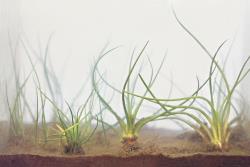Aquatic (NZ) or occasionally terrestrial (not NZ). Plants growing from a lobed (in transverse section) and erect (NZ) or elongate (not NZ) corm-like stem that gives rise to a tuft of roots and a cluster of erect leaves, completely or partially submerged or occasionally terrestrial; leaves evergreen when submerged, or losing their leaves in dry periods when terrestrial. Scales absent. Leaves spirally arranged, ligulate, undivided, with a single unbranched vein surrounded by four longitudinal air canals divided by transverse septae; all leaves similar, linear, either terete and winged at base, with a subulate or acuminate apex (NZ), or flattened with a spathulate or rounded, apiculate apex (not NZ); leaf margins entire, bases swollen and colourless. Sporophylls similar to leaves, bearing sporangia that are embedded on the adaxial face of the swollen leaf base. Sporangia ovoid or globose, indehiscent, partially or completely covered by a thin membrane (velum). Heterosporous; mega- and microspores usually produced in separate sporangia (NZ) or rarely in the same one (not NZ). Megaspores trilete, with pronounced laesurae and equatorial ridge, variously patterned from almost smooth to verrucate or tuberculate, 250–800 μm in diameter. Microspores monolete, variously patterned but usually echinate, 20–40 μm in diameter.
A family with one genus and from 192 (Troia et al. 2016) to 250 species (PPG 1 2016).
Isoetaceae have long been recognised as one of three isolated families within the Lycopodiopsida, distinguished by their submerged or semi-aquatic habitat, tufts of linear undivided ligulate leaves, and heterosporous spores that are produced inside the swollen bases of the leaves. The range of variation within the family has been summarised by Jermy (1990).
Isoetaceae comprise aquatic or semi-aquatic lycophytes that bear ligulate, undivided leaves with single, unbranched veins. Plants grow from a corm-like stem producing tufts of leaves that are usually evergreen, or in some species may be lost in dry periods. The leaves have conspicuous air chambers. Spores are produced in solitary sporangia in the swollen leaf bases and released as the leaves decay. Plants are heterosporous, with mega- and micro-sporangia usually produced in separate sporangia.
A medium-sized cosmopolitan family, widespread from the cold-temperate zones in both hemispheres to the tropics, and growing from sea level to over 4000 m (Jermy 1990; Chinnock 1998), but absent from most of the Pacific islands. Two endemic species in New Zealand.
| Category | Number |
|---|---|
| Indigenous (Endemic) | 2 |
| Total | 2 |




